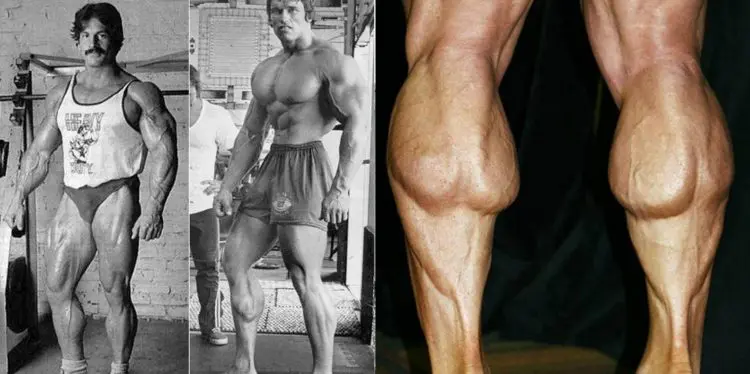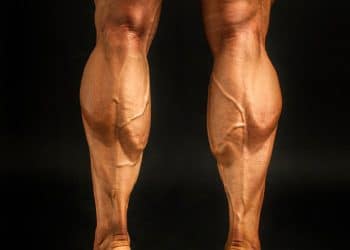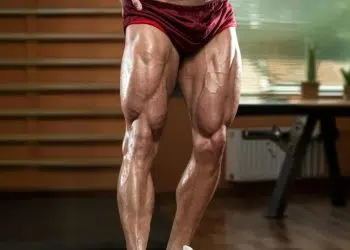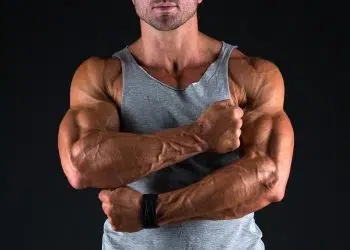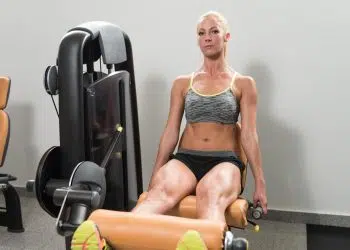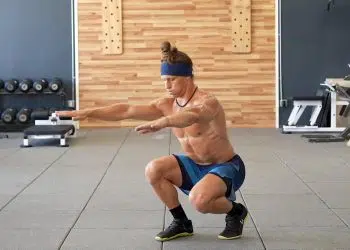How many different pec exercises do you do? Three? Four? Five? How about lat exercises, or for your biceps? Most bodybuilders like to hit their muscles from all available angles to maximize hypertrophy. In fact, studies confirm that using a variety of exercises is crucial for optimal growth and getting stronger, not to mention staying motivated and warding off boredom (1).
So, why is it that, when it comes to calf training, most people settle for just two exercises – standing and seated calf raises?
While there is nothing wrong with either of these exercises, if they are all you ever do, your progress will soon stall. Maybe that’s why so many exercisers complain that they can’t get their calves to grow!
In this article, we reveal the 13 best seated and standing calf raise variations and alternatives. Use these exercises to liven up your lower body workout or any time you don’t have access to the necessary calf raise machines.
Calf Anatomy
For such a small muscle group, your calves are surprisingly complex. Knowing a little more about the anatomy of your calves will help you understand why some exercises and workouts are better than others for turning your little calves into massive cows!
Level Up Your Fitness: Join our 💪 strong community in Fitness Volt Newsletter. Get daily inspiration, expert-backed workouts, nutrition tips, the latest in strength sports, and the support you need to reach your goals. Subscribe for free!
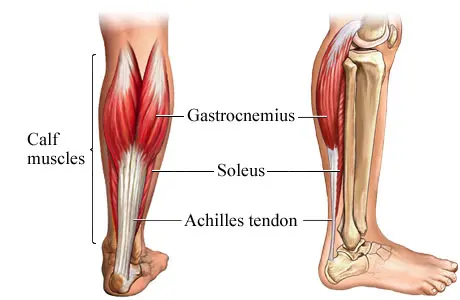
The muscles that make up your calves are:
1.Gastrocnemius: This is the largest of the two calf muscles. Gastrocnemius is a biarticular muscle which means it crosses two joints and has two functions:
- Plantar flexion of your ankle joint (pointing your toe)
- Flexion of your knee joint. Yes, the primary muscle responsible for knee flexion IS your hamstrings, but gastrocnemius provides assistance.
2. Soleus: The soleus muscle is your lower, smaller calf muscle. It lies beneath and below your gastrocnemius. Soleus only crosses your ankle joint, so it only has one main function:
- Plantarflexion of your ankle joint
Gastrocnemius and soleus have different origin points but share the same insertion. Because of this, they’re often known as the triceps surae. Both calf muscles come together at your Achilles tendon, which attaches to your heel bone, properly called your calcaneus.
Despite this shared anatomy, it is possible to emphasize one calf muscle more than the other. Pointing your toes with your knee straight focuses on your gastrocnemius. But, when you bend your knee, the soleus becomes more active. Because of this, most good calf workouts include both standing and seated calf movements.
The 13 Best Calf Raise Alternatives
Are you bored of doing the same old calf workout with standing and seated calf raises? Or maybe you train at home and don’t have access to calf raise machines? Either way, we’ve got 13 of the best calf raise variations and alternatives for you!
1. Donkey calf raise
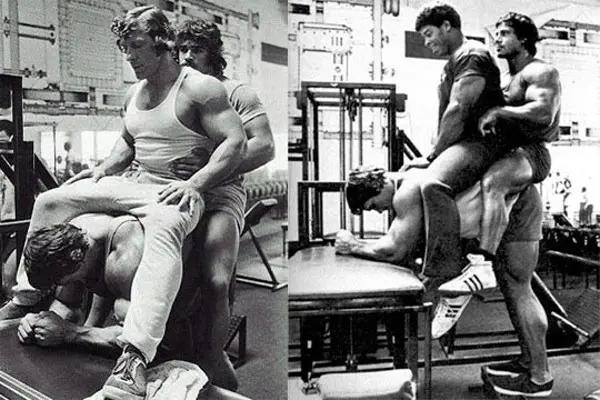
While doing this exercise will undoubtedly raise a few eyebrows at the gym, it’s a very effective way to build bigger calves. Emphasizing your gastrocnemius, the only thing you need to do this exercise is a willing training partner or two for ballast!
How to do it:
- Stand with your toes on a raised platform, such as a couple of 45lb plates or a length of 2” x 4” wood. Lean forward and rest your hands on a nearby bench so your torso is parallel to the floor. Brace your abs.
- Ask your training partner to carefully sit across your hips and not your lower back.
- Once they are in position, push up onto your tiptoes, lower your heels back down to stretch your calves, and repeat.
- You can also do this exercise beneath a Smith machine, although you’ll probably need to pad the bar to protect your lower back.
2. Two up one down calf raises
You are stronger eccentrically than you are concentrically. That means your can LOWER more weight than you can LIFT. This exercise, which can be done on seated or standing calf raises, makes the most of this phenomenon so you can really overload your lower legs.
How to do it:
- Using a seated or standing calf raise machine, rise up onto your tiptoes on both legs.
- Next, shift your weight over so it’s all on one calf only.
- Lower your heel down slowly using just one leg.
- Use both legs to push yourself back up and then lower your weight down using the opposite leg.
- Alternate legs for the rest of your set.
3. Single leg calf raise
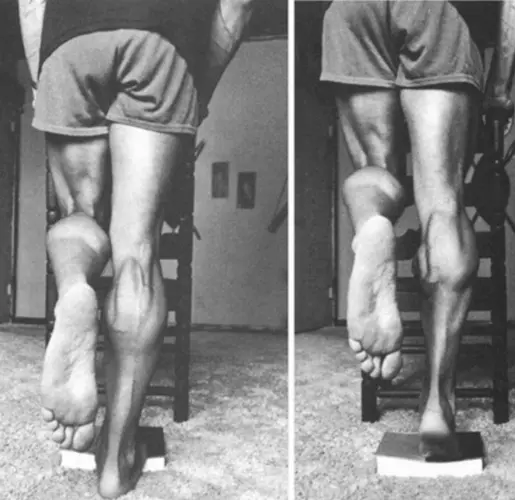
No calf raise machine? No problem! This exercise is every bit as effective, and, best of all, you just need a step and a dumbbell to do it.
How to do it:
- Stand on one leg on a 4-6″ high step. Place the ball of your foot on the edge of the step, so your heel is free to move up and down. Cross your ankles and use your hands for balance.
- Keeping your supporting knee straight, rise up onto your tiptoes and then lower your heel down toward the floor.
- Continue for the prescribed number of repetitions and then change legs.
- Hold a dumbbell in one hand to make this exercise harder.
4. Tiptoe farmer’s walk
Have you ever noticed how a lot of overweight people have HUGE calves? It seems that walking around with a lot of weight on your calves could help them grow. This exercise is designed to simulate this effect.
How to do it:
- Hold a heavy dumbbell in each hand. Use straps if you need to reinforce your grip.
- Rise up onto your tiptoes.
- Without lowering your heels, walk around your training area until your calves are pumped and burning.
- You could also do this exercise with a barbell across your upper back.
Related: Farmer’s Walk Guide: How-To, Muscles Worked, Variations, and Benefits
Level Up Your Fitness: Join our 💪 strong community in Fitness Volt Newsletter. Get daily inspiration, expert-backed workouts, nutrition tips, the latest in strength sports, and the support you need to reach your goals. Subscribe for free!
5. Explosive calf raise
This is another trick for increasing the eccentric overload when doing calf raises. In addition, using an explosive concentric increases muscle fiber recruitment. Be warned; this exercise is GUARANTEED to give you very sore calves!
How to do it:
- Position yourself on a standing calf raise machine or Smith machine (with plates to elevate the feet) so that your knees are slightly bent. Brace your core.
- Keeping your torso straight, explode upward using your quads, and forcefully point your toes.
- With your legs straight, slowly lower your heels down to get a good stretch, and then repeat.
6. Leg press calf raise
You don’t need a calf raise machine when you’ve got a leg press! You can train your calves on most leg press machines. If you look at the position of your body, you’ll soon see that leg press calf raises are a lot like donkey calf raises (exercise #1).
How to do it:
- On a loaded leg press machine, press the footplate up and then carefully position the balls of your feet on the lowermost edge.
- Keeping your legs straight, lower the weight, and then push it back up.
- Take care not to let the balls of your feet slip off the footplate. This would cause a catastrophic injury.
7. Ankle jumps
Athletes who do a lot of sprinting and jumping tend to have large, powerful calves. This exercise provides your lower legs with an effective plyometric workout. This is an excellent way to finish your regular calf training program.
How to do it:
- Stand with your feet together and your hands by your side.
- Keeping your knees as straight as possible, jump up and down on the spot by pushing off your toes. Do not let your heels touch down.
- Continue for the prescribed number of reps.
- Jump from side to side to work the lateral (side) aspect of your calves.
- Too easy? Hop on one leg instead or hold dumbbells in your hands.
8. Hack squat machine calf raise
This is another alternative to standing calf raises. It works your calves from a slightly different angle, which is crucial for building bigger muscles. Brace your core to keep your spine stable and keep your knees locked out throughout your set.
How to do it:
- Face the backrest of your hack squat machine. Place your shoulders beneath the pads and the balls of your feet on the edge of the footrest. Straighten your legs and lift the weight.
- Keeping your core tight and your knees straight, push up onto your tiptoes, and then lower your heels down as far as you can.
- Keep going until you have completed all the prescribed reps.
9. Dumbbell shrug to calf raise
While the range of movement is not all that impressive, this is a very time-efficient way to train two muscles at the same time – your calves and your upper traps. Because it’s a freestanding exercise, you will need to use your calves to stabilize your ankles, which should increase muscle fiber activation.
How to do it:
- Hold a heavy dumbbell in each hand, arms by your sides. Your feet should be between shoulder to hip-width apart.
- Rise up onto your tiptoes. Keeping your heels up, shrug your shoulders up toward your ears.
- Lower your shoulders, slowly return your heels to the floor, and repeat.
10. Seated no-machine calf raises
Seated calf raises emphasize your soleus, which is your lowermost calf muscle. The easiest way to train your soleus is by using a seated calf raise machine. But, if you train at home or otherwise don’t have access to a seated calf raise, you can do this exercise using a bench, step, and a pair of dumbbells.
How to do it:
- Sit on your bench with your legs bent and your toes on the edge of a step, length of 2” x 4” wood, or a couple of 45lb weight plates. Your shins should be vertical.
- Rest your dumbbells on your knees. You can also use a barbell.
- Lower your heels down toward the floor to stretch your calves.
- Rise up onto tiptoes and repeat.
- You can also do this exercise using one leg at a time.
11. Calf raise 21s
21s, also known as the matrix training system, is usually associated with biceps training. However, you can use this method on almost any muscle group, including your calves. Try 21s on standing and seated calf raises to add some much-needed variety to your next lower leg workout.
How to do it:
- Seated or standing, lower your heels all the way down and get a good stretch in your calves. This is your starting position.
- From this stretched position, do seven half-reps, bringing your heels up, so they are level with your toes.
- Next, do seven reps from halfway up to your tiptoes.
- Finally, do seven full reps.
- You can use 21s on most of the calf raise exercises in this guide.
12. Myo-reps calf raises
Like 21s, you can use this training method with most types of calf raises. Myo-reps are a great way to cram a lot of training into a short amount of time. Use the myo-reps method when you don’t have the time or energy to train your calves for longer or as a finisher after your regular calf workout.
How to do it:
- Using your preferred calf raise exercise, rep out until you reach failure. Make a mental note of how many reps you did.
- Rest 15-20 seconds.
- Do another set but, this time, do 25% of the reps you did in the first set. So, if you did 20 reps initially, your next set will be five reps.
- Rest another 15-20 seconds.
- Continue until you have completed five “mini-sets” or cannot do 25% of your original set.
Related: Myo-Reps: What Are They and How to Use Them
13. Calf raises burn reps
If your calves aren’t growing, maybe it’s time to turn your training intensity up to the maximum setting! Burn reps extend your set to increase time under tension and flood your muscles with loads of lactic acid, both known triggers for muscle growth. This IS going to hurt, but that may be the price you have to pay for bigger calves. Use this training method with all the calf exercises in this article.
How to do it:
- Perform your chosen calf raise to failure. Finish your set on your tiptoes.
- Next, lower your heels just an inch or two and then push back up.
- Continue with these micro-reps until the burn becomes unbearable.
- Rest 1-2 minutes and repeat.
Wrapping Up
Regular seated and standing calf raises are fine exercises, but if they’re all you ever do, your progress will eventually stall. After all, what do you think would happen if you just did bench presses and push-ups for your pecs or leg presses and leg extensions for your quads?
Avoid progress plateaus by adding some variety to your workouts. Not just for the big muscle groups, but smaller muscles like your calves, too.
A lot of people blame their lack of calf development on genetics. However, lack of workout variety is more likely to be the reason you’ve got chicken legs.
Start adding some extra meat to your lower legs with the 13 best calf raise alternatives.
References:
1 – PubMed: The Effects of Exercise Variation in Muscle Thickness, Maximal Strength and Motivation in Resistance Trained Men (source)
Interested in measuring your progress? Check out our strength standards for Bench Press, Push Ups, Seated Calf Raise, and more.

